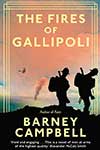|
The Fires of Gallipoli
by Barney Campbell

|
This is Barney Campbell’s second novel. The first, Rain, published in 2015 (reviewed in the Winter 2015/16 edition) was about Afghanistan, where Barney had served. As a former soldier, he has seen the realities of war, the physical violence, and the human dimension: comradeship, elation, despair, fear, and at times boredom. War is an extension of normal life yet also an aberration, hard to comprehend without first-hand experience. All of this can been found in Rain, which made it such a powerful and compelling novel. For this reason, it has been likened to the great memoirs of the First World War, such as Robert Graves’ Goodbye to All That.
While both books are works of fiction, in The Fires of Gallipoli the author has had to draw on his powers of imagination more than in Rain, although his experience of war has certainly added to its authenticity. However, there are also other parallels which help to make this book work as a novel, although differently to the first.
The author has chosen the Gallipoli campaign of 1915 as the backdrop for the book, which compares in some ways to the much longer Afghanistan campaign in the early 2000s. Both seemed a good idea at the time, but we now know them to have been ill-advised expeditions and doomed to failure. Afghanistan and Gallipoli ended with defeat for the British and their allies, however bravely their armies had fought on the battlefield.
The Fires of Gallipoli begins not in April 1915, when the landings on the Gallipoli peninsula took place, but a month later when even the most optimistic of observers might have begun to worry about the outcome. The story opens in Valletta, Malta, with officers of the Queen Anne’s Own waiting impatiently to get into the fight. It is clear that none of them, including the main protagonists, the young Edward Salter and Theo Thorne, have any experience of war. They talk about Aeschylus’s play, Agamemnon, and Homer’s The Iliad, a conversation reminiscent of Rupert Brooke’s letter to Violet Asquith in which he describes his naive ambition, ‘...since the age of two – to go on a military expedition against Constantinople….’ These young men are from a similar background to Brooke, but they did at least get to Gallipoli; Brooke died of septicaemia from a mosquito bite on a hospital ship near the Greek island of Skyros just two days before the Gallipoli landings on 25th April 1915.
The descriptions of the fighting on the peninsula are visceral, literal, and violent, far more so than in the real memoirs of the First World War, which were often more oblique in their descriptions of reality. There is much here about the stench of war, the blood, smashed and decaying bodies, the appalling weather, the flies, the filth and disease, and the truly ghastly life in the trenches that were never as well-constructed or carefully sited as those on the Western Front. The landscape of Gallipoli and the prevailing conditions are well described here, altogether a pretty grim place. The author has clearly spent time on the peninsula as his vivid and descriptive narrative demonstrates. Gallipoli is now beautiful and tranquil, but it was a dreadful place for fighting in 1915: extremely hot in summer and desperately cold in the winter. All of this comes through in the book.
Gallipoli remains centre-stage in the story until around half-way through the book, when the troops withdraw, abandoning their equipment and dead comrades to the triumphant Turkish Army. The tone of the book changes from there on, a welcome relief from the unrelenting violence of the earlier chapters. Edward and Theo, who have by now forged a close friendship, spend a brief period of leave in England during which Edward meets Theo’s sister Miranda, someone we know will appear again in the story. Edward is then appointed to Field Marshal Kitchener’s staff, becoming his ‘eyes and ears’, visiting units at the front, while Theo, the more naturally assured of the two, returns to his battalion in France. From there on, their relationship becomes both distant and confused, a reflection of the traumas of war.
There are some interesting factual diversions along the way, with the brief introduction of real people, most notably General Sir Ian Hamilton, Kitchener, and, very briefly, Clement Attlee, a future prime minister. His appearance, early in the book, is not repeated, although he is somewhere in the shadows, the penultimate man to be evacuated from Suvla Bay in Gallipoli, behind Edward Salter and Theo Thorne.
There is also an interesting inference of conspiracy later in the book, surrounding Kitchener’s drowning in June 1916, during his sea passage to Russia. Just a small diversion which the author accepts for what it is: no more than a remote strawman suggesting that the facts of Kitchener’s death might not be quite as they seemed.
The Fires of Gallipoli is a well-written novel, with vivid scene-setting and realistic dialogue. Soldiers’ banter is probably as timeless as war itself, and certainly there will be some familiarities here for anyone who has experienced military service. While the book ends on an upbeat note, one senses a strange feeling of foreboding. Life in the aftermath of war is not going to be simple and straightforward and, with the benefit of hindsight, we know what is coming around the corner. Perhaps, hopefully, there is a sequel on its way. Does Edward Salter remain in the Army, or does he return to his life as a solicitor? And where does he go as the war clouds darken again in the 1930s? We will wait and see.
The Editor
Elliott and Thompson Limited |
|

